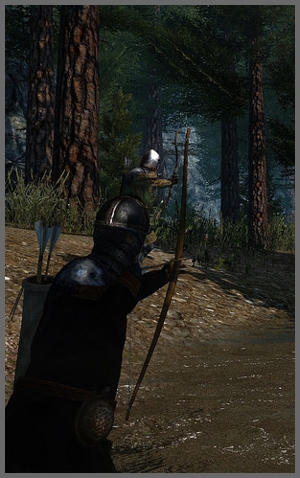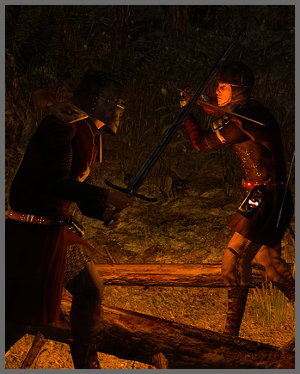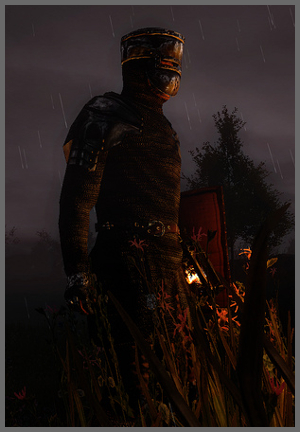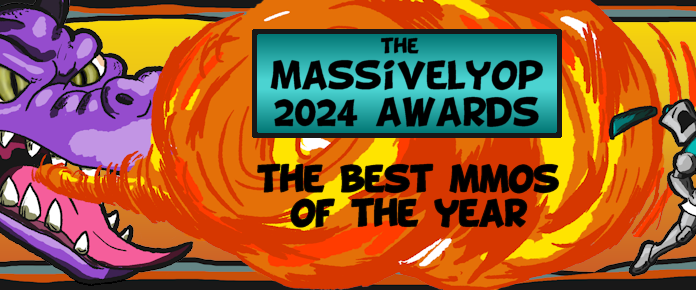
We’re in the midst of a sort of sandbox renaissance, with numerous sandbox titles under development and more seeming to scuttle out of the woodwork on a regular basis, all vying for the attention of the masses of gamers weary of the World-of-Warcraft-inspired theme park formula that has dominated the market for so long. Among these contenders is Gloria Victis from indie developer Black Eye Games, a medieval, low-fantasy title that aims to meld an open-world sandbox MMO with the frantic swordplay action popularized by games like Mount and Blade and Chivalry.
Gloria Victis, like many of its compatriots in this new wave of sandbox MMOs, is still in development, but players can get a look at the current state of the game through Steam’s Early Access program. But if you’re one of the many who are (justifiably) wary of dropping money on unreleased games, don’t fret: I’ve taken the plunge in your stead to take a look at how things are shaping up.
For those of you who haven’t been following Gloria Victis, here’s a bit of background: Per the official description on Steam, the game is a sandbox MMORPG “with an emphasis on realism, set in a low-fantasy medieval open world.” Boasting “skill-based non-target combat” and a focus on PvP – in both formal tournaments and open-world, territory-control battles – Gloria Victis aims to give players the freedom to roam its medieval world, inspired by feudal Europe and Islamic-caliphate Middle-East, and to build their reputations as chivalrous knights, marauding outlaws, master artisans, or however else they see fit to build their characters through the game’s classless progression system.
Even in its current pre-alpha state, Gloria Victis’s character creation is fairly robust, albeit obviously incomplete – most notably, female characters have not yet been implemented. The first and arguably most important choice players make at character creation is to which nation they will pledge their allegiance. There are currently three nations from which to choose (a fourth and final nation is slated to be added by launch), with each nation further subdivided into two “origins,” though these seem to be purely for flavor and have no apparent impact on gameplay except in the case of characters belonging to the Azebian Empire, whose starting location changes based on the origin selected.
 The first of the three currently-implemented nations is Midland, composed of the independent-but-allied kingdoms of Logres to the west and Wenedia to the east. Defined by their pride, order, and dedication, the Midlanders seem to draw inspiration from feudal England and its chivalric orders of knights. Next is the nation of Ismir, a confederation of clans and the jarls that lead them from the harsh, frigid land of Nordheim. Inspired by Viking-age Scandinavia, their defining characteristics are fury, ferocity, and freedom. The last of the currently available nations is the Azebian Empire, comprised of the once-great Sangmar—whose last unconquered city of Baalhammon embodies their defining traits of wisdom, ambition, and perfection—and their former slaves turned conquerors, the Azebs. The Sangmarians call to mind the caliphates of the Islamic Golden Age, while the Azebs – whose key traits are listed as tenacity, determination, and perseverance – seem to be an amalgamation of Middle-Eastern cultures and the nomadic peoples of the Mongolian steppes.
The first of the three currently-implemented nations is Midland, composed of the independent-but-allied kingdoms of Logres to the west and Wenedia to the east. Defined by their pride, order, and dedication, the Midlanders seem to draw inspiration from feudal England and its chivalric orders of knights. Next is the nation of Ismir, a confederation of clans and the jarls that lead them from the harsh, frigid land of Nordheim. Inspired by Viking-age Scandinavia, their defining characteristics are fury, ferocity, and freedom. The last of the currently available nations is the Azebian Empire, comprised of the once-great Sangmar—whose last unconquered city of Baalhammon embodies their defining traits of wisdom, ambition, and perfection—and their former slaves turned conquerors, the Azebs. The Sangmarians call to mind the caliphates of the Islamic Golden Age, while the Azebs – whose key traits are listed as tenacity, determination, and perseverance – seem to be an amalgamation of Middle-Eastern cultures and the nomadic peoples of the Mongolian steppes.
After choosing my character’s nation (the Azebs hadn’t been added when I created my character, so I went with the Midlanders) and finalizing his physical features, the last order of business was to choose his archetype and allocate his initial attributes. There are six archetypes to choose from, and although their names may vary depending on national allegiance, they’re ultimately the same throughout. Three are combat-focused – one with light armor, one with medium armor, and one with heavy armor – and the other three (called Tailor, Armoursmith, and Weaponsmith regardless of nation), are tooled toward crafting. It’s important to point out, however, that a character’s archetype determines only his starting equipment and has no impact on his long-term capabilities.
Once in the game-world proper, I was given some short tutorial popups that showed me how to navigate the UI (which is remarkably clean and unobtrusive, if a bit rough around the edges), guided me to the first quest-giver NPC, and walked me through the basics of melee and ranged combat. From there, I was on my own.
It was during this initial quest, which tasked me with recovering wine from a caravan that had been waylaid by bandits, that the roughness of the game’s pre-alpha stage first became apparent. The basic mechanics of movement are fine, for the most part, but jumping is abysmal; even when sprinting at full-speed, my character comes to a choppy halt before actually executing the jump, and it seems like a crap-shoot as to whether my character actually maintains his forward momentum or simply jumps ineffectually in place. Some physics weirdness when jumping isn’t that big of a deal, though; I’m not here to jump hurdles, I’m here to kick some ass, medieval-style. Unfortunately, however, the current combat system isn’t in much better shape.
 First, a quick primer on the combat mechanics: Attacking, blocking, sprinting, and jumping all expend stamina, the amount and regeneration rate of which is determined in various degrees by your strength, dexterity, and constitution scores. If you’ve ever played Mount and Blade, Gloria Victis’s combat controls should be familiar: Attacks are performed by pressing LMB while moving your mouse in the direction you wish to attack (forward, backward, left, or right), and attacks can be charged by holding LMB. Holding a charged attack slowly consumes stamina, and if you hold it for too long, the charge will dwindle back down to standard, non-charged power. Blocking works similarly, though as far as I can tell, attack and block direction matters only in PvP combat at present.
First, a quick primer on the combat mechanics: Attacking, blocking, sprinting, and jumping all expend stamina, the amount and regeneration rate of which is determined in various degrees by your strength, dexterity, and constitution scores. If you’ve ever played Mount and Blade, Gloria Victis’s combat controls should be familiar: Attacks are performed by pressing LMB while moving your mouse in the direction you wish to attack (forward, backward, left, or right), and attacks can be charged by holding LMB. Holding a charged attack slowly consumes stamina, and if you hold it for too long, the charge will dwindle back down to standard, non-charged power. Blocking works similarly, though as far as I can tell, attack and block direction matters only in PvP combat at present.
It’s a solid system, and I laud Gloria Victis’s efforts to bring the intense feint-block-parry-attack dynamics of Mount and Blade to an MMO space, but in its current implementation, I’m afraid it falls rather flat. Hit-detection is dodgy at best; there’s often a noticeable delay between when an attack appears to land and when the blow actually registers, assuming that it registers at all. Similarly, I’ve had attacks get blocked even though the enemy’s block animation didn’t occur until well after my swing appeared to connect, and I’ve in turn blocked attacks that I had absolutely no right to. The problem is especially egregious in ranged combat, where I’ve personally witnessed multiple instances of the game insisting that my shot didn’t land even though the arrow sticking out of my target’s face would suggest otherwise.
In a game where timing and spacing are both of the utmost strategic importance, it’s a huge problem to be unable to rely on the visual attack animations to gauge whether a blow will actually land. Collision detection between character models is similarly hit-or-miss (pun absolutely intended), and I’ve lost count of how many attacks I’ve whiffed because the enemy just pranced right through my character’s model mid-swing. It’s worth noting, though, that these issues seemed much more pronounced in fights against NPCs than in PvP battles, which is a bit baffling to me, but given the emphasis Gloria Victis puts on PvP, it’s certainly not a bad thing. Nevertheless, hit- and collision-detection are in dire need of tune-ups in both PvE and PvP situations.
Although PvE isn’t exactly the primary focus of the game, it is nevertheless how most players will spend the early game to earn the XP and gear necessary to fend for themselves in PvP. Gloria Victis’s PvE isn’t exactly revolutionary, but it manages to provide a decent amount of variety for players not yet ready to join the PvP fray. The quest system in Gloria Victis is a pretty routine affair – get quests from NPCs, go kill X dudes or get Y things, report to NPC, and repeat. I do appreciate that the objectives tend to contain a mix of combat and resource-gathering, allowing players who are interested in focusing on crafting to accrue materials as they quest. There are also a number of public events that crop up throughout the map, but many of them are pretty buggy, so objective completion doesn’t always register, making them exercises in frustration more than anything else.
The game’s promotional material touts among its features a “complex crafting system,” and while this is technically true, I think the devs would do well to keep in mind that complexity and depth are not necessarily synonymous. Gloria Victis utilizes a sort of modular crafting system, wherein each crafted item is comprised of numerous crafted components whose quality helps to determine the overall quality of the final product. For example, almost every crafted weapon requires a wooden handle, but the type of wood from which said handle is crafted will influence the power of the finished weapon.

Crafted equipment can also range in quality from the standard, baseline item to the exceptional “item +6.” I tend to enjoy crafting systems that allow experienced crafters to create higher-quality versions of basic items, but my issue with Gloria Victis’s implementation is that the quality of an item is almost entirely at the mercy of RNG. When crafting an item, the probability of an item being of higher quality is determined by a combination of factors such as the crafter’s skill level in the relevant craft, the quality of the materials used, and whether or not the item is crafted at a workshop.
Obviously, crafters can actively take certain steps to increase the odds of a higher-quality item, but when it comes down to it, all they can do is pray to the gods of RNG that they make something worth a damn. This can be frustrating enough in games like Final Fantasy XIV, which utilizes a binary system wherein an item is either high-quality or it isn’t; I can only imagine the frustration inherent in a system such as Gloria Victis where item quality is divided into seven different tiers.
Last, but not least, we come to what is arguably the single most emphasized facet of Gloria Victis: open-world PvP. Now, I’ll go ahead and preface this by saying that I didn’t spend a great deal of time with PvP, partially because I’m a universally terrible PvPer in every game I play and partially because of the rage-factor of the aforementioned hit- and collision-detection issues, so take everything that follows with a grain of salt. That being said, I think that the PvP is easily the strongest aspect of the game so far, and it’s also perhaps the most central of all the game’s systems.
The main focus of PvP in Gloria Victis is the capture and control of territory, usually castles or keeps. Capturing and controlling the contested points scattered across the map is essential for those who want to have the best gear, as the vendors who sell the best items and recipes in the game are accessible only by those whose faction controls the keeps and fortresses where they are located. I only took part in a couple of proper sieges, and even then I spent most of my time dying, but right now the mechanics are pretty rudimentary. Siege engines and the like are yet to be implemented, so at present sieges essentially amount to wars of attrition, with huge numbers of players throwing themselves at walls and buildings, chipping away at them until one side can no longer fight.
 It’s hard for me to pinpoint particular areas in which sieges could be improved, largely because the ones in which I was involved were so chaotic that I usually didn’t know what the hell was happening until I died an unceremonious death. That being said, I got the impression that, since friendly fire is a thing, most besiegers are relegated to using spears or other thrusting weapons almost exclusively, so as to minimize the chance of accidentally cutting down your teammates in the close-quarters brawls into which sieges inevitably devolve. The more I think about it, the more I’m convinced that the current state of siege warfare relegates players into a single build; light and even medium armor seem objectively inferior to heavy armor, as mobility means very little when you’re in the middle of a massive crowd trying desperately to stay alive, and as I mentioned before, friendly fire makes weapons with large arcs of attack a liability more than anything else.
It’s hard for me to pinpoint particular areas in which sieges could be improved, largely because the ones in which I was involved were so chaotic that I usually didn’t know what the hell was happening until I died an unceremonious death. That being said, I got the impression that, since friendly fire is a thing, most besiegers are relegated to using spears or other thrusting weapons almost exclusively, so as to minimize the chance of accidentally cutting down your teammates in the close-quarters brawls into which sieges inevitably devolve. The more I think about it, the more I’m convinced that the current state of siege warfare relegates players into a single build; light and even medium armor seem objectively inferior to heavy armor, as mobility means very little when you’re in the middle of a massive crowd trying desperately to stay alive, and as I mentioned before, friendly fire makes weapons with large arcs of attack a liability more than anything else.
As with everything else I’ve written so far, though, the siege combat mechanics are subject to change greatly between now and release, so hopefully more playstyles will become viable as the systems are tweaked and added to. In the game’s current state, it’s hard for me to recommend Gloria Victis to any but the most hardcore of PvP fanatics, and even they will need a high threshold for frustration until the kinks in hit-detection are worked out. But that being said, the game is nothing if not ambitious, and though it may be more than a little rough around the edges at present, if Black Eye Games is able to smooth out the wrinkles as development continues, this could be the foundation for a unique and complex PvP sandbox. We’ll just have to keep an eye on Gloria Victis as it matures to see whether it ripens or rots with time.













